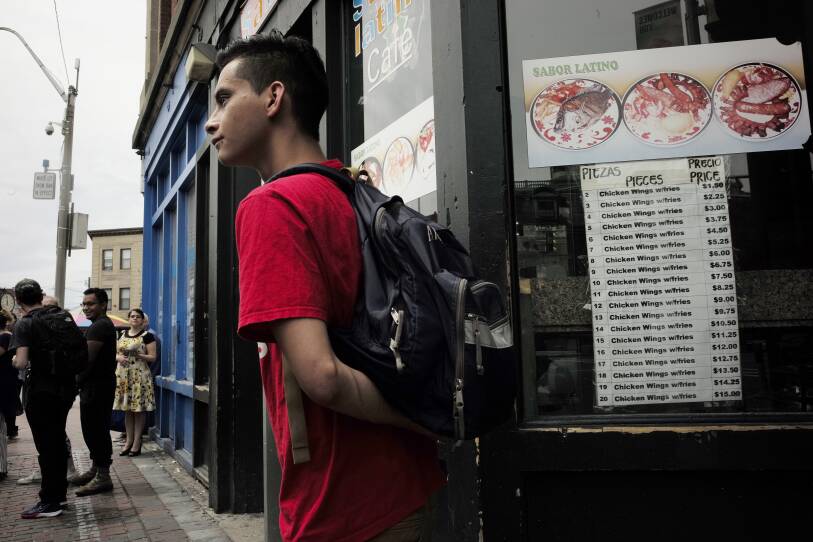Mexican immigrant Gonzalo Mendez spearheaded a class action lawsuit after his 8-year-old daughter wasn't allowed to attend the same school as white children in their town.
The year was 1947 and the case, Mendez v. Westminster, ultimately led to school desegregation throughout California and the nation. The decision influenced the United States Supreme Court to declare segregated public schools unconstitutional in the landmark Brown v. Board of Education ruling in 1954. Despite its powerful impact, it may be the most important desegregation case you've never heard of.
"It's amazing that we have lost so much of the history, that we don't know more about Mendez," said Iván Espinoza-Madrigal, executive director of Lawyers for Civil Rights in Boston. "It's amazing that it even took 20 years after Brown versus Board of Education for Boston to be in full compliance with integration."
On the 75th anniversary year of the case, Mendez v. Westminster still holds lessons for Massachusetts, a state where the Hispanic population has grown nearly 200% since 1990 and nearly one out of every four students is Latino. Researchers say there is cause for concern about a rising number of intensely segregated non-white schools in the state, a number that climbed to 192 from 143 in the last decade, according to research by Pennsylvania State, UMass Lowell and Old Dominion University .
"Many districts with intensely segregated non-white schools have the demographic capacity to foster integration," the report said. "And as Massachusetts becomes more racially diverse, more and more districts should be able to foster school diversity across the Commonwealth."
The landmark Mendez case
Sylvia Mendez was 8 years old when her father launched the legal battle that would change education in America with a separate but not equal ruling by a judge. She has recalled in interviews being forced to walk to a "terrible little shack" of a school in Westminster's barrio during the legal proceedings.
"My father thought it was such an injustice," she said in a GBH interview in 2005 .
More Music & Culture
California saw a surge of Mexican immigrants in the 1940s because of political turmoil in Mexico and the availability of jobs in the U.S. But Mexican immigrants faced discrimination, and were excluded from public pools and white restaurants. While the school bus dropped off all students in Westminster in front of a tidy stucco school, only white students — or those who passed for white — were welcome inside. Dark-skinned Mexican children had to keep walking to the "Mexican school."
While Felicitas Mendez ran the family's farm, Gonzalo Mendez hired an attorney and rallied other families to join their complaint. As a young lawyer, the NAACP's Thurgood Marshall filed an amicus brief supporting the Mendez lawsuit. And he won in U.S. district court. The school district appealed and again lost, allowing thousands of Mexican children to attend better schools across southern California. That federal appellate court ruling eventually helped Marshall persuade the US Supreme Court to declare segregated public schools unconstitutional seven years later.
Sylvia Mendez, now in her 80s, has said in interviews that she was welcomed at her new school — mostly. One white classmate told her Mexicans didn't belong at the school, bringing her to tears the first day. She didn't want to go back, but did to appease her parents.
"I discovered that everyone's not born with hatred in their heart, because the next day I was invited to children's homes and birthday parties," she said in a speech at Cypress College in 2018.
Uneven resources and opportunities in 2022
In Massachusetts, the Latino population has grown to more than 850,000 residents in recent years and Latino students comprise the ethnic majority of students in many districts, including Boston, Springfield, New Bedford, Fall River and other “Gateway” cities. In Lawrence, 94% of students are Latino, and in Chelsea, 88%.

Chelsea School Committee member Roberto Jimenez Rivera said the increasingly unaffordable housing market drives segregation and creates uneven educational opportunities for students of color across the state. While there are state efforts to fund schools more fairly in districts that have less school revenue from property taxes, he said he still has concerns.
"You think about how in Massachusetts, because we have such small towns and cities, you essentially end up segregating resources and kind of hoarding opportunity in places out in the suburbs that don't have as many students of color," Rivera said.
Many mostly white suburbs see the value of diversity, he added, so there's the METCO program, which buses Black and Latino students from Boston to suburban schools. But the program is small and participation is voluntary .
Ruby Reyes, director of the Boston Education Justice Alliance, said the prosperous city of Boston has schools with wildly varying resources, including schools where bathroom stalls lack doors or toilet paper. Some schools don't have libraries or art and music programs. Many aging facilities desperately need repairs.
"Boston has this terrible legacy, but also has never really worked to dismantle it in a systematic way," she said.
At the city's prestigious exam schools, despite improvements designed to make admissions more equitable, families that can afford tutoring services still have an advantage. The Advanced Work Class offers an accelerated curriculum for grades 4-6 and is a gateway to exam school admissions, but it operates in only a few schools.
"You see these moments where you take two steps forward, and then, you know, folks try to take two steps back."Ruby Reyes
Reyes says Latino parents line up to speak at school committee meetings as late as 11 p.m. to air their concerns. But there is no dialogue with school committee members, who under meeting protocols do not respond during public comment periods. School committee members in Boston are also appointed by the mayor, not elected.
The Mendez case feels relevant to this day, Reyes suggested, because change comes so slowly in Boston, if at all.
"Because Boston's history is so rooted in old kind of racism, right, you see these moments where you take two steps forward, and then, you know, folks try to take two steps back," she said.
Parents still have to fight for language and other supports, she said. Under Superintendent Brenda Cassellius, six different people have been in charge of education for the city's English Learners Office in less than three years. At the same time, middle-class Latino families are fighting to keep stability in their children's lives when rents are on the rise.
"They just want a quality education"
Thurgood Marshall, fresh off the Supreme Court victory in Brown v. Board, predicted in 1954 that the work around educational fairness was far from over.
"We do believe that this decision in itself will encourage people to take steps beyond litigation," he said after the Supreme Court's decision.
The Mendez ruling offered one kind of remedy for desegregation that drew the attention of then California Gov. Earl Warren, who desegregated schools across the state. He was later appointed to the U.S. Supreme Court, where as chief justice he lobbied for and won a unanimous ruling in the Brown v. Board of Education.
It would take another 20 years and more infamous court and busing battles for Massachusetts to comply with the desegregation laws.
Tatiana M.F. Cruz, a history professor at Simmons University, said Latino activists in Boston didn't uniformly endorse desegregation efforts in the Boston schools in the 1970s.
Latino parents and activists had already worked to ensure bilingual education was available in some schools as well as Latino teachers and principals. Desegregation threatened to disperse those bilingual clusters of students.
"So what happens is you now separate all the Latinx students in an effort to integrate, that also means potentially reducing all of these programs and services that the Latinx community fought for so hard," Cruz said. "So I think it's complicated. I think, you know, the Latinx community in Boston had their own alternative ideas of what was best for their children."
Cruz said one thread that runs through decades of school desegregation cases is as simple as it is profound: Black and brown parents fighting for a good education for their children.
"Folks often think that everybody's just seeking integration. You know, that's a common narrative, right?" Cruz said. "That all of these Black and brown families wanted integration, they wanted their kids to sit next to white students. But in fact, they just want a quality education."
In 2018, Sylvia Mendez lamented the modern-day segregation she sees in cities, workplaces and schools. She recalled being asked to deliver a graduation speech at a California school named for her parents. She said she balked to learn that the student body was 100% Latino.
"What does that tell you when a student body is 100% Latino?" she asked. "It tells you it's segregated."






